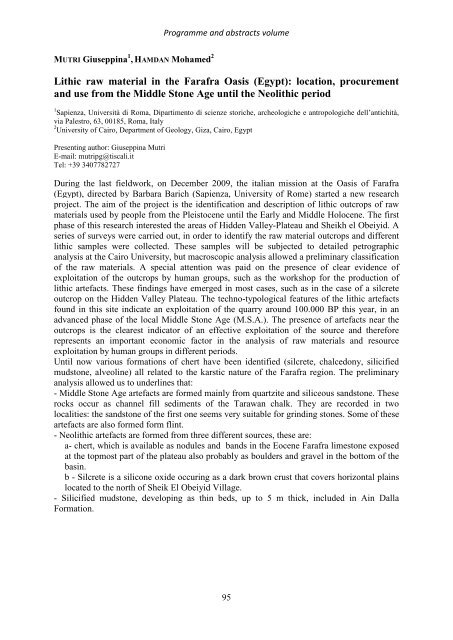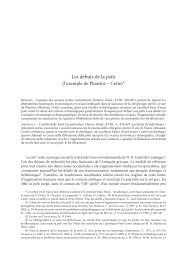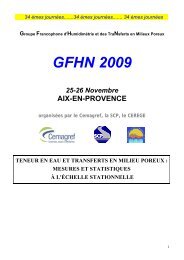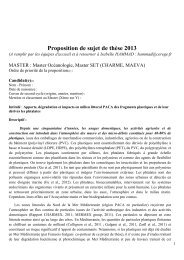LANDSCAPE ARCHAEOlOGY. EGYPT AND THE ... - CFEETK - CNRS
LANDSCAPE ARCHAEOlOGY. EGYPT AND THE ... - CFEETK - CNRS
LANDSCAPE ARCHAEOlOGY. EGYPT AND THE ... - CFEETK - CNRS
Create successful ePaper yourself
Turn your PDF publications into a flip-book with our unique Google optimized e-Paper software.
Programme and abstracts volume<br />
MUTRI Giuseppina 1 , HAMDAN Mohamed 2<br />
Lithic raw material in the Farafra Oasis (Egypt): location, procurement<br />
and use from the Middle Stone Age until the Neolithic period<br />
1 Sapienza, Università di Roma, Dipartimento di scienze storiche, archeologiche e antropologiche dell’antichità,<br />
via Palestro, 63, 00185, Roma, Italy<br />
2 University of Cairo, Department of Geology, Giza, Cairo, Egypt<br />
Presenting author: Giuseppina Mutri<br />
E-mail: mutripg@tiscali.it<br />
Tel: +39 3407782727<br />
During the last fieldwork, on December 2009, the italian mission at the Oasis of Farafra<br />
(Egypt), directed by Barbara Barich (Sapienza, University of Rome) started a new research<br />
project. The aim of the project is the identification and description of lithic outcrops of raw<br />
materials used by people from the Pleistocene until the Early and Middle Holocene. The first<br />
phase of this research interested the areas of Hidden Valley-Plateau and Sheikh el Obeiyid. A<br />
series of surveys were carried out, in order to identify the raw material outcrops and different<br />
lithic samples were collected. These samples will be subjected to detailed petrographic<br />
analysis at the Cairo University, but macroscopic analysis allowed a preliminary classification<br />
of the raw materials. A special attention was paid on the presence of clear evidence of<br />
exploitation of the outcrops by human groups, such as the workshop for the production of<br />
lithic artefacts. These findings have emerged in most cases, such as in the case of a silcrete<br />
outcrop on the Hidden Valley Plateau. The techno-typological features of the lithic artefacts<br />
found in this site indicate an exploitation of the quarry around 100.000 BP this year, in an<br />
advanced phase of the local Middle Stone Age (M.S.A.). The presence of artefacts near the<br />
outcrops is the clearest indicator of an effective exploitation of the source and therefore<br />
represents an important economic factor in the analysis of raw materials and resource<br />
exploitation by human groups in different periods.<br />
Until now various formations of chert have been identified (silcrete, chalcedony, silicified<br />
mudstone, alveoline) all related to the karstic nature of the Farafra region. The preliminary<br />
analysis allowed us to underlines that:<br />
- Middle Stone Age artefacts are formed mainly from quartzite and siliceous sandstone. These<br />
rocks occur as channel fill sediments of the Tarawan chalk. They are recorded in two<br />
localities: the sandstone of the first one seems very suitable for grinding stones. Some of these<br />
artefacts are also formed form flint.<br />
- Neolithic artefacts are formed from three different sources, these are:<br />
a- chert, which is available as nodules and bands in the Eocene Farafra limestone exposed<br />
at the topmost part of the plateau also probably as boulders and gravel in the bottom of the<br />
basin.<br />
b - Silcrete is a silicone oxide occuring as a dark brown crust that covers horizontal plains<br />
located to the north of Sheik El Obeiyid Village.<br />
- Silicified mudstone, developing as thin beds, up to 5 m thick, included in Ain Dalla<br />
Formation.<br />
95








